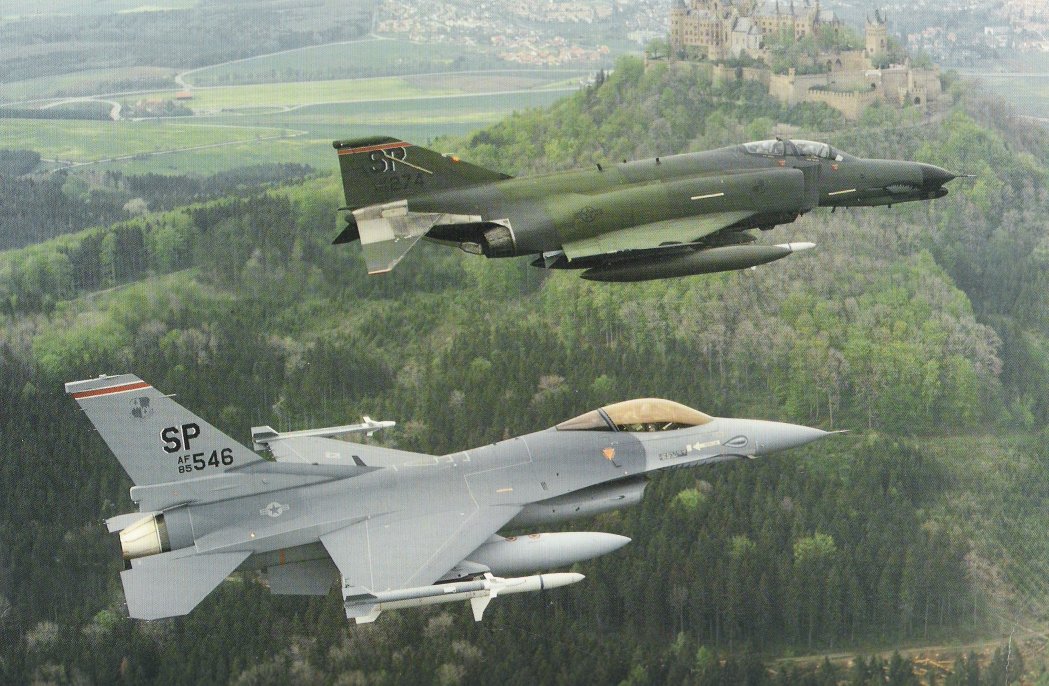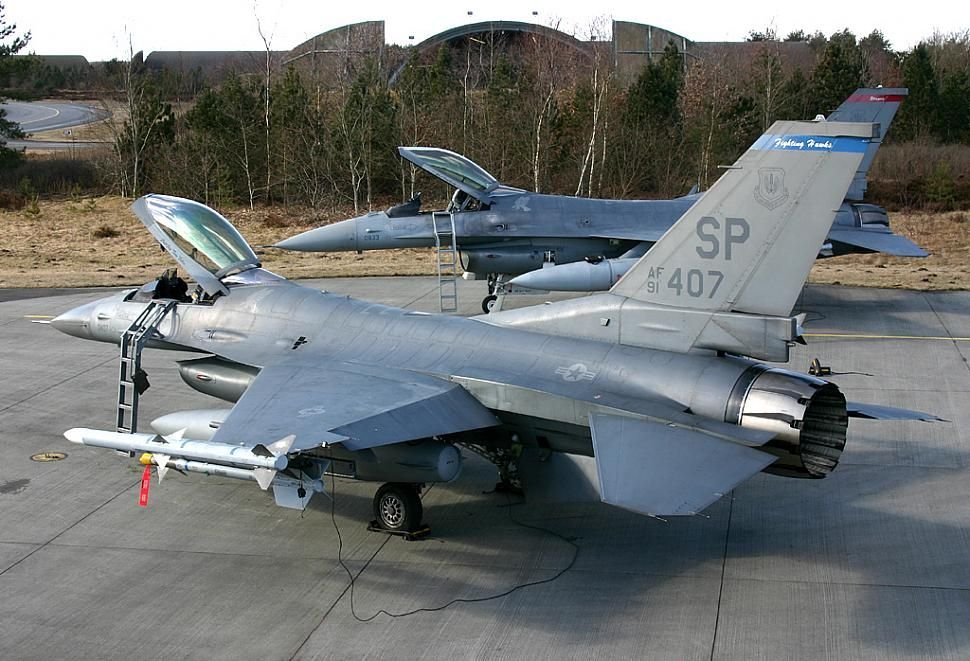
Historiek
De F-16C Block 30 and F-4G in deze foto waren allebei toegewezen aan het 480ste TFS, wat de eerste USAF eenheid ooit was die twee verschillende vliegtuigen gebruikte in de rol van jager-schutter.
Ze deden dat vanaf april 87 tot november 90.
De foto is genomen in 1988. Tegen 1989 waren de Phantoms reeds overschilderd in twee tonen grijs. Met de introductie van nieuwere en performantere wapensystemen spitste de F-4 zich toe op het onderdrukken van de vijandige luchtafweer. De F-4G Advanced Wild Weasel was het laatste model Phantom in de USAF, tot het werd vervangen door de F-16CJ/DJ in de rol van het opsporen en onderdrukken of vernietigen van radargeleide luchtartillerie en grond-lucht raketinstallaties. De F-4G was een gemodificeerde F-4E waarbij gesofisticeerde elektronica de plaats innam van het interne 20mm kanon. De F-4G kon meer wapens meenemen dan vorige Wild Weasel vliegtuigen, evenals een grotere variëteit aan raketten en conventionele bommen. Het belangrijkse wapen van de F-4G was de AGM-88 HARM. Andere munitie omvatte onder meer clusterbommen, de AGM-78 Standard ARM en de AGM-65 Maverick. Ook lucht-luchtraketten behoorden tot zijn arsenaal. Het voorgestelde model draagt van al deze wapens één of twee exemplaren mee, allemaal blauw gemerkt om aan te geven dat het om oefenversies gaat, dus zonder springlading. Onder de romp een brandstoftank, en een AN/ALQ119 ECM stoorgondel. Gedurende een periode in de late jaren 1980 en de vroege jaren 1990 werkten twee verschillende generaties USAF straaljagers samen in de rol van onderdrukken van vijandelijke luchtafweer. In deze ongewone regeling werden de F-16C en de F-4G samen ingezet als een Wild Weasel jager/schutter team, dat in staat was de vijandelijke radargestuurde luchtafweerdreiging in alle weer te localiseren en te vernietigen. De geschiedenis van de F-16 in het 23ste TFS was vrij uniek. Het eskader was een gespecialiseerde Wild Weasel eenheid, die vloog met de respectabele F-4E en F-4G versie van de Phantom. Ze werden als zogenaamd jager/schutter team ingezet, waarbij de F-4G de SAM installaties opspoorde, en de F-4E ze uitschakelde met AGM-45 Shrike raketten, en later met de AGM-88 HARM. In de late jaren 80 was de F-4E dringend aan vervanging toe. Begin 1987 begonnen de eerste kleine groep F-16C block 30 (met kleine luchtinlaat) eraan te komen. Hoewel de invoering van de F-16 evenwel een behoorlijke opwaardering betekende in vergelijking met de oude F-4E, was deze versie van de F-16 nog niet in staat de SEAD rol volledig zelf op zich te nemen en moest hij steunen op de capaciteiten van de F-4G. De volledige SEAD-taak kon de F-16 pas vervullen met de komst van de F-16C block 50 in 1990. Het voorgestelde model draagt onder de romp een AN/ALQ 131 ECM stoorgondel, en onder de vleugels zien we brandstoftanks, een AGM-88 HARM raket en twee CBU-87 clusterbommen, twee AIM-120 AMRAAM lucht-luchtraketten en twee AIM-9J Sidewinder lucht-luchtraketten. Ook hier zijn alle wapens oefenmunitie. Op het einde van Operation Desert Storm in 1991 werden alle F-4G toestellen doorgespeeld aan het 81ste FS en werd het 23ste een F-16 eenheid. Doordat aan het einde van de koude oorlog diverse eskaders werden opgeheven, werd Hahn AFB gesloten en haar eenheden opgeheven. De nucleaire aanvalsrol moest dus een nieuwe gastheer krijgen. Het 23ste werd voor deze taak uitgekozen. In 1994 begonnen de eerste nagelnieuwe block 50 toestellen aan het eskader geleverd. Doorheen de jaren werd het eskader actief betrokken bij noodoperaties doorheen Europa en Azië. Het eskader werd bij talrijke gelegenheden ingezet in het midden-oosten, voor Operation Northern or Southern Watch missies. Ook de Balkanoorlog was een gevechtstheater voor het eskader. |
History
The F-16C Block 30 and F-4G in this photograph were both assigned to the 480th TFS, which was the first USAF unit ever to use two different aircraft in the role of a single hunter-killer mission.
They did so from april 87 to november 90.
The picture was taken in 1988. By 1989 the Phantoms were painted in a two-tone grey scheme. With the introduction of newer, more capable weapons systems, the F-4 mission narrowed to the suppression of enemy air defenses. The F-4G Advanced Wild Weasel, was the last model in the active Air Force inventory, until it was replaced by the F-16CJ/DJ in the role of seeking out and suppressing or destroying enemy radar-directed anti-aircraft artillery batteries and surface-to-air missile sites. F-4G's were Emodified models where sophisticated electronic warfare equipment replaced the internally mounted 20mm gun. The F-4G could carry more weapons than previous Wild Weasel aircraft and a greater variety of missiles as well as conventional bombs. The primary weapon of the F-4G, however, was the AGM-88 HARM (high speed anti-radiation missile). Other munitions included cluster bombs, the AGM-78 Standard ARM and the AIM-65 Maverick. Air-to-air missiles were also carried. The model shown totes one or two of each, painted blue to indicate that they are training rounds without explosive charge. Below the fuselage it carries an F-15 external fuel tank and a AN/ALQ119 ECM pod. For a period in the late 1980s and early 1990s different generations of USAF fast jets worked together in the suppression of enemy air defences role. This unusual arrangement saw the F-16C and F-4G paired together into Wild Weasel "hunter/killer" teams capable of locating and destroying enemy radar-guided, surface-to-air threats in all weather. The history of the F-16 within the 23rd TFS was quite unique. The squadron was a dedicated Wild Weasel unit flying the venerable F-4E and G versions of the Phantom. They were employed in the so-called ‘hunter/killer’ role with the F-4G hunting SAM sites and the F-4E killing them with the AGM-45 Shrike and later AGM-88 HARM missiles. In the late 1980’s the F-4E was in urgent need of replacement. In early 1987 the first small mouth block 30 airframes started to arrive. Although the introduction of the F-16 meant a considerable upgrade compared to the old F-4E, this version of the F-16 wasn’t yet capable to take on the SEAD role completely on its own, still having to rely on the F-4G for the "hunting" part. The F-16C only fully assumed the SEAD task with the introduction of the block 50 model in 1990. The model shown totes a AN/ALQ 131 ECM jamming pod below the fuselage, while under the wings we see external fuel tanks, an AGM-88 HARM missile and two CBU-87 clusterbombs, two AIM-120 AMRAAM air to air missiles and two AIM-9J Sidewinders. Again all weapons are training rounds. At the end of Operation Desert Storm in 1991 all the F-4G airframes were transferred to the 81st FS with the 23rd becoming an all F-16 unit. With the dwindling down of USAFE squadrons after the end of the Cold War, Hahn AFB was closed and its units disbanded. The nuclear strike role therefore needed a new host. The 23rd was selected for this task. In 1994 the first brand-new block 50 airframes started to arrive with the squadron. Over the years the squadron became actively involved in contingency operations throughout Europe and Asia. On numerous occasions the squadron was deployed to the Middle East for Operation Northern or Southern Watch missions. The squadron also saw action in the war over the Balkan. |
Bouwverslag
Dit is een projectje waar ik al heel lang zin in had. De benodigde bouwdozen lagen reeds jaren op mij te wachten in mijn stash.
Beide zijn Hasagawa kits, dus de bouw verliep zonder noemenswaardige problemen. Zoals gebruikelijk bij Hasegawa is er maar weinig wapentuig aanwezig in de kits, al heeft de F-4G kit wel een AGM-78 Standard ARM en een AGM-45 Shrike meegekregen. Ook een F-15 centerline droptank zit er bij. Alle andere zaken onder romp en vleugels van de F-4G en alles van de F-16C haalde ik bij de Hasegawa Aircraft Weapons kits. Voor de F-4G haalde ik er nog een Black Box cockpit bij, wat er voor zorgde dat ik de gesloten cannopies uit één stuk niet kon gebruiken, en noodgewongen voor de open variant moest kiezen. |
Building the kits
This is a project I've been wanting to do for a long time. The kits needed had been sitting in my stash for years.
Both kits are from Hasegawa, which means that building them went without a hitch. As usual with Hasegawa the kits come with only very little in the way of ordnance, although the F-4G kit comprises a AGM-78 Standard ARM and an AGM-45 Shrike. Also an F-15 style centerline droptank is provided. All other F-4G weapons and everything hung underneath the F-16C, I got from the Hasegawa Aircraft Weapons kits. For the F-4G I used a Black Box cockpit, which precluded using the closed one-piece cannopies and forced me to settle for the open variant. |
  The genuine articles |
|